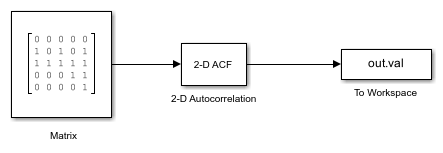2-D Autocorrelation
2-D autocorrelation of input matrix
Libraries:
Computer Vision Toolbox /
Statistics
Description
The 2-D Autocorrelation block computes the 2-D autocorrelation of the input vector or matrix.
Examples
Ports
Input
Output
Parameters
Block Characteristics
Data Types |
|
Multidimensional Signals |
|
Variable-Size Signals |
|
Algorithms
If the input Ais a vector with dimension M-by-1 then the equation for 1-D discrete autocorrelation is:
where .
The output is an autocorrelation vector of size .
If the input A is a matrix with dimension M-by-N then the equation for the 2-D discrete autocorrelation is:
where and .
The dimension of the output autocorrelation matrix is .
Extended Capabilities
Version History
Introduced before R2006a

